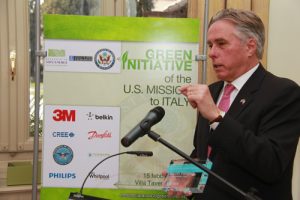Rome, Italy
U.S. Embassy Rome implemented significant green technology improvements at the U.S. Ambassador’s residence, Villa Taverna, a historically significant building. The upgrade was executed in conjunction with the League of Green Embassies’ (the League) Energy Efficiency Sweep initiative for COM residences, a collaborative effort involving the Department, the U.S. Department of Commerce, the Alliance to Save Energy, and corporate vendors of efficiency products and equipment.
U.S. Ambassador Thorne explains the technology upgrades to M’illumino di meno event attendees
Image Source: The League of Green Embassies
At Villa Taverna, Post installed light-emitting diode (LED) interior and exterior lighting fixtures; thermal window film; heating, ventilating, and air conditioning (HVAC) and building controls upgrades; ‘smart’ power strips that combat phantom loads; water faucet aerators; and high efficiency washers, dryers, refrigerators, wine coolers, and microwaves. Combined, the improvements are expected to reduce electricity costs by 48% ($30,000 per year).
One of the primary challenges was determining how to maintain the cherished historical character of Villa Taverna, a 16th century Italian villa. The project team carefully considered the preservation of historical design elements when implementing environmental strategies. For example, inefficient lamps in chandeliers were replaced with similar-looking LEDs, demonstrating just one of the ways in which the project team was able to retain the building’s character while implementing new technology. Previous upgrades at the residence included site improvements, such as rainwater collection for irrigation and the establishment of vegetable gardens.
To coincide with a national ‘M’illumino di meno’ (‘I use less light’) energy efficiency consciousness-raising campaign, Post held an event on February 15th, 2012, to highlight the building improvements, increase awareness and education, and support the mission of eco-diplomacy.


